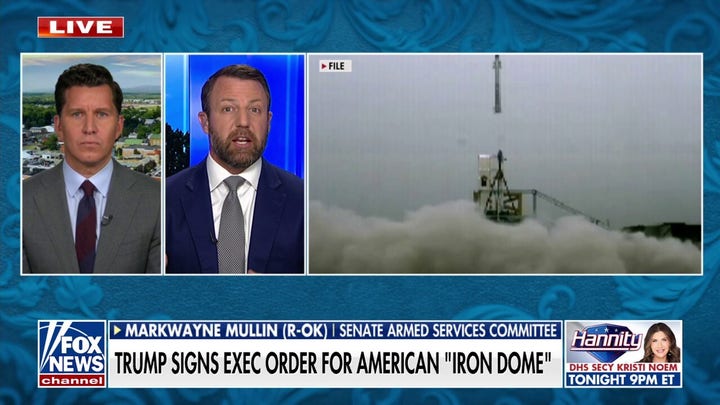President Donald Trump has ordered the construction of an advanced, next-generation missile defense shield to protect the United States from aerial attack.
On Monday, the president signed an executive order that tasks Defense Secretary Pete Hegseth with drawing up plans to build an ‘Iron Dome for America’ that will protect Americans from the threat of missiles launched by a foreign enemy. In doing so, Trump kept a campaign promise to prioritize missile defense.
‘By next term we will build a great Iron Dome over our country,’ Trump said during a West Palm Beach event on June 14. ‘We deserve a dome…it’s a missile defense shield, and it’ll all be made in America.’
But what exactly are Trump’s plans for an ‘Iron Dome’? Here’s what you need to know:
1. Israel’s first defense
The Iron Dome missile defense system Trump has called for is similar to one that Israel has developed to intercept thousands of rockets.
Israel’s first line of defense, a missile defense system developed by Rafael Advanced Defense Systems, is labeled the Iron Dome. It was first deployed in 2011, and has since rebuffed and destroyed rockets from Hamas terrorists, Hezbollah forces and Iranian drones and missiles.
The Iron Dome is land-based and built to keep the citizens of Israel safe from barrages of rockets deployed most often by Palestinian terrorists in the Gaza Strip. Israeli officials claim the Iron Dome has been 90% effective in intercepting thousands of rockets fired into Israel.
The U.S. has contributed at least $2.6 billion to the development of Israel’s Iron Dome system since 2011.
2. The threats facing the U.S.
Critically, the Iron Dome is a short-range defense system capable of tackling missiles with ranges between 2.5 miles and about 43 miles. Trump’s executive order identifies attack by long-range ballistic, hypersonic and cruise missiles as ‘the most catastrophic threat facing the United States,’ so his proposed defense system will need to be adapted and redesigned to defend against intercontinental missiles.
Russia currently has an arsenal of 1,250 deployed weapons, according to the New York Times. Pentagon analysts believe China will have a weapons stockpile of similar size within 10 years, if not earlier, and North Korea has continued development of intercontinental ballistic missiles under both Trump and President Joe Biden’s watch.
Most recently, Russia and China have experimented with hypersonic missiles, which are designed to exceed Mach 5, or five times the speed of sound. Intercepting missiles at such speeds is a challenge the U.S. has partnered with Japan to confront at an estimated cost of $3 billion, the Associated Press reported.
3. Reagan tried it first
President Ronald Reagan was the first U.S. president to call for a national defense system that would counter the threat of the Soviet Union’s nuclear weapons, including warheads attached to ballistic missiles.
On March 30, 1983, Reagan proposed ‘a vision for the future that offers hope’ that he called the Strategic Defense Initiative (SDI). The idea was to develop a space-based missile defense program that would protect the country from large-scale nuclear attack. Reagan proposed to develop technology that would allow the United States to identify and automatically destroy numerous incoming ballistic missiles before they reached their targets.
Acknowledging that the technology to realize his vision did not yet exist, Regan urged the scientific community to partner with the defense community and work towards a future where Americans need not fear nuclear attack.
‘I call upon the scientific community in our country, those who gave us nuclear weapons, to turn their great talents now to the cause of mankind and world peace, to give us the means of rendering these nuclear weapons impotent and obsolete,’ Reagan said.
The president’s critics derided the plan, nicknaming it, ‘Star Wars,’ and questioned why his administration would pursue a costly defense initiative with no guarantee that it would work. The Soviet Union accused Regan of violating a 1972 Anti-Ballistic Missile Treaty that committed both countries to refrain from developing missile defense systems. Arms control measures stalled during Reagan’s term because he refused to give up the project.
After Regan left office, interest in SDI waned and the program was canceled before the U.S. could develop a functional missile defense system. However, research conducted while SDI was active contributed to the Iron Dome’s development. In 2002, the U.S. withdrew from the Anti-Ballistic Missile Treaty, which now allows Trump to pick up where Reagan left off.
4. Hegseth’s to-do list
Under Trump’s order, freshly confirmed Defense Secretary Pete Hegseth must submit to the president ‘a reference architecture, capabilities-based requirements, and an implementation plan for the next-generation missile defense shield.’
The plans must include defense against ‘ballistic, hypersonic, advanced cruise missiles, and other next-generation aerial attacks from peer, near-peer, and rogue adversaries.’
Hegseth is also instructed to accelerate the deployment of a satellite-based sensor system developed by the Missile Defense Agency that is currently in its prototype phase. Called the Hypersonic Ballistic Tracking Space Sensor, the system uses ‘birth-to-death’ tracking to follow missile threats from launch through interception, according to the Defense Department.
Additionally, Trump’s order instructs the development and deployment of several space-based missile interception technologies, including systems that could disable a missile prior to launch, as well as a ‘secure supply chain’ to ensure that the ordered missile defense infrastructure is made in America.
Hegseth must also submit a plan to pay for these dense systems before the president puts together his fiscal year 2026 budget.
5. Cooperating with U.S. allies
Trump’s order calls to ‘increase bilateral and multilateral cooperation on missile defense technology development, capabilities, and operations,’ as well as to ‘increase and accelerate the provision of the United States missile defense capabilities to allies and partners.’
Hegseth is also directed to conduct a review of the U.S. military’s missile defense posture in theaters across the globe and identify areas for cooperation with allies.
Fox News Digital’s Gabriele Regalbuto contributed to this report.

